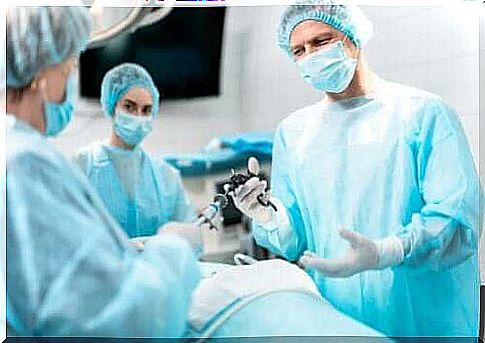The Purpose And Implications Of A Laryngectomy

In this article, we want to discuss the purpose and implications of a laryngectomy, a surgical procedure that completely removes the larynx. This type of surgery causes major changes in those who undergo it. The most relevant is the loss of the pharynx, changes in the sense of smell, changes in breathing and changes in personal appearance.
Those who undergo a laryngectomy must have a tracheostomy for the rest of their lives. This is an opening in the trachea, with a tube in it, that facilitates the passage of air to the lungs. This implies the need for permanent care.
The effects of a laryngectomy are very diverse and involve different daily limitations. For example, these patients need to re-educate their voice and may have difficulty swallowing food.
Who Should Have a Laryngectomy?

In the larynx, there are two distinct pathways: one leads to the stomach (esophagus) and the other to the lungs (larynx and lung tube). The larynx shares a common space with the esophagus, the pharynx. A laryngectomy removes the larynx, thereby breaking the connection between the mouth and the lungs.
Removing the larynx is a very serious operation that doctors only perform when there is no other alternative. When will this happen? In the following cases:
- There is severe trauma to the larynx. That is, significant damage from a gunshot wound or the like.
- The patient has cancer in the larynx.
- There is radiation necrosis. In other words, severe damage to that area from radiation therapy.
What does the procedure consist of?
Laryngectomies require general anesthesia. The surgeon makes incisions in the neck and thereby removes the larynx. In some cases, the doctor may also remove part of the pharynx and/or lymph nodes.
After removing the larynx, the doctor makes a hole in the front of the trachea. This is called a stoma and is about the diameter of a penny. Then they will insert a tube or cannula to connect the lungs to the outside.
Finally, the surgeon creates a suture with surgical suture. Drainage tubes are usually placed in the neck to remove fluids and blood from the surgery site. Upon completion, the patient should be taken to the recovery room.
Sometimes doctors also perform a tracheo-oesophageal puncture (TEP – Spanish link) during a laryngectomy. This is a small hole in the windpipe and esophagus. They put in a valve so that the hole stays open. The goal is to keep food out of the trachea without blocking the passage of air.
The potential risks
All surgeries carry risks. Some of the most common include bleeding, infections, allergic reactions to drugs, breathing problems, and heart problems. With a laryngectomy in particular, there are other risks, such as the following:
- Hematoma or accumulation of blood due to rupture of the thyroid arteries.
- The development of fistulas (Spanish link). That is, abnormal channels or connections between the pharynx and the skin.
- Anastomotic stenosis. A condition in which the opening of the stoma becomes too small.
- Leakage. Occurs between the tracheostomy and the tracheoesophageal perforation (TEP).
- Damage to the trachea or esophagus.
- Difficulty speaking.
- Difficulty swallowing food.
What to Consider Before a Laryngectomy?
Before a laryngectomy, doctors must perform a series of tests and examinations. They usually request a blood test and sometimes also imaging tests. The doctor will also do a complete physical exam.
The patient must have a consultation with a swallowing therapist and a speech therapist. This will help you prepare for the implications of a laryngectomy. You should also have the advice of a nutritionist. If you smoke, you should stop smoking and receive support and information to help the patient quit.
You should also inform your doctor about the medications you are taking. In addition, you should inform your doctor if you regularly drink alcohol and, in the case of women, if you are pregnant or if there is a risk of pregnancy.
In addition to the above, the following indications should be added:
- Avoid drugs that hinder blood clotting. This measure will take effect one week before the operation.
- The patient should not consume any food or drink for 12 hours before surgery.
- If the patient has a beard or mustache, he should shave it off.
- Follow any other instructions your doctor gives you.
The implications of a laryngectomy

After the larynectomy, the patient will most likely stay in the Intensive Care Unit (ICU) for several days. He or she should be given food through a tube that runs from the nose to the stomach. The patient also receives oxygen through the stoma and painkillers.
When the condition stabilizes, you will go to a hospital room, where you will stay for about 10 days. During that time you learn to talk and eat again. You will also get help to get used to the new way of breathing.
After the hospital stay, you should continue the rehabilitation process. This includes the two basic aspects, which we will summarize below.
Ostomy care
One of the main implications of a laryngectomy is the care of the stoma, as viruses and bacteria can enter with the potential to cause infection. That is why it is essential to learn how to take care of it. For example, the edges of the stoma should be cleaned with water, mild soap and gauze.
Crusts and mucus form in the stoma. These must be removed to allow air to flow properly into the lungs. Sometimes a strong cough is enough to remove these accumulations. However, if this is not possible, they must be removed manually. The person who has had surgery must be trained how to do this.
It is important to have a humidifier at home. This helps to prevent crusting on the stoma. Sometimes the use of a special mask that provides humidified air is also recommended. Its use is temporary.
Speech rehabilitation after a laryngectomy
Another one of the main implications is that it causes the sound of the voice to change significantly. The air no longer circulates in the same way and this causes major changes in the way sounds are emitted. It is important to develop new ways of communicating and relearn how to speak.
In principle, non-verbal communication can be used, through gestures or sign language. Some of the voice recovery alternatives include the following:
- Esophageal speech or esophageal speech. This involves trapping air from the mouth into the upper esophagus and throat. Although difficult to learn, this technique can produce speech.
- Electrolaryngeal speech. This includes placing a device to produce voice and speech. It sounds robotic, but is easy to use and solves the problem in the short or long term.
- TEP speech. A voice prosthesis is connected to the TEP valve (that of the tracheo-oesophageal puncture). This is placed over the stoma and allows speech.
Also read:
Removing a foreign object from the esophagus
A laryngectomy is life-changing
Every laryngectomy has major implications that are life-changing. However, by following your doctor’s instructions and with a lot of perseverance, you can achieve an almost normal daily life. It is possible to breathe, speak and eat again in a way that does not cause great discomfort.
The greatest risk is the clogging of the stoma, as it cuts off breathing. This can be prevented with proper training. A person having a laryngectomy also needs psychological support as they are going through a lot of psychosocial changes.









